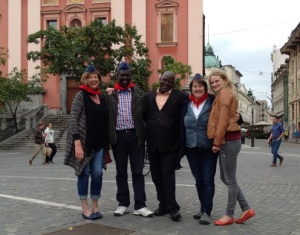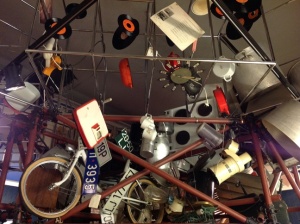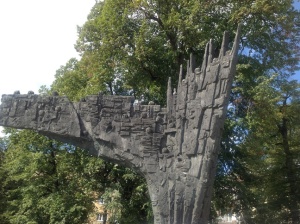A sense of curiosity seems to come naturally to me, especially for those things I have never experienced directly. I would put Communism in that category. As I move around Slovenia I experience the country as it is now. The books I read give me some glimpses into the difficult days spanning pre-WWI, through WWII and into the struggle for independence: The Tree with No Name, Northern Lights, Joyce’s Pupil (Drago Jancar), Murisa (Feri Lainscek), The Hidden Handshake (Ales Debeljak), Portrait of the Artist as a Young Man (James Joyce), Fuzine Blues (Andrej Skubic), and the poems of Srecko Kosovel. An opportunity to learn more, experientially, presented itself in the form of the Ljubljana 4-Hour Heritage of Communism Tour, the brainchild of Lidija Deu and Mateja Kregar Gliha, both of whom grew up in post-WWII Yugoslavia – Lidija in Ljubljana, and Mateja a stone’s throw from Ljubljana. Through their eyes and memories, stories and anecdotes, I came closer to understanding life and living during the days of Tito’s leadership.
INDUCTION
Resplendent in blue caps and red neck scarves, we took part in a ceremony re-enacting the graduation of elementary school students to the status of Pioneer. This ceremony, on the Day of the Pioneers, was carried out on September 29 each year from 1947 until 1989/90. The caps and scarves were prized possessions, worn on all special occasions.
NEIGHBOURHOOD PLANNING
The beginning of the Sixties saw intentional urban development modelled on neighbourhood planning methods via Sweden. Walking through one of these communities was certainly an eye-opener. Savsko naselje, Lidija’s home as a child, comprised approximately 2,000 apartments and housed 7,000 people. Down every street, and around every corner, she burst with enthusiasm and happy memories of the time she spent living and playing with her neighbourhood friends. Everything was included in the planning: shops, services, schools, day care, sports facilities, playgrounds. It is a very green area, with grass and tree-lined streets. Each neighbourhood includes unique car parking arrangements. I’d always wondered what purpose those structures served. Now I know! With its level of greenness and its proximity to the centre of Ljubljana, Savsko naselje is a desirable address today and maintains its property values.
ARTEFACTS & GOODS
A wonderful display of manufactured products from the era is housed in the Museum of Contemporary History. Some of the goods continue to be produced to this day, others are lovingly remembered and stored in memories of the past. The production of milk over time, and its related purchase cost, was visually represented with coins. It’s a good thing we have paper notes now, or our wallets would have to be monstrous! Another insight was the vast number of badges produced as incentives to employees for commitment to their work. Both Lidija and Mateja reflected on their personal collections of these. Gamification has all kinds of applications! And an encouragement to save was represented by an array of money boxes from metal and clay to plastic.
THE SNACK-ATTACK PACK
All senses were catered for. Even taste! This came in the form of a “Communist” snack. First of all there was a bottle (original packaging) of Cockta, a soft drink that went onto the market in 1953. Made from dog-rosehip and 11 secret herbs and spices, it’s not unlike but beats Coca Cola handsdown. In my opinion! For the sweet-tooths there was a packet of Kiki candies. And for savoury lovers there was a bread roll, zemljica, together with Kekec (he’s a character from children’s literature)brand speadable paste. What more could anyone want during an absorbing afternoon of immersion in all things communist?
BUILDINGS
I was really surprised to learn that the Parliament Building dates back to the late Fifties. The clean lines, contrasting textures and colours, and the arrangement of figures around the entrance I find particularly appealing. In the same way, the simplicity and style of the Gallery of Modern Art entirely suits its purposes, and this building, too, is a product of the Communist era. Not quite in the appealing category, but no less significant are the ‘twin towers’ on one side of Republike trg. They were the HQ for Iskra, one of the largest Yugoslav workers’ self-management systems – capitalism under the red banner – a system created by Edvard Kardelj and epitomising Yugoslavia’s specific economic and ideological path. An example of one of their enterprising items was the telephone…so advanced for its time that it was chosen as the means of communication for the Moscow Olympics.
FIGURES & MONUMENTS
Every society remembers its past and its figureheads with monuments dedicated to their memory and contribution. And Slovenia is no different. What characterises her public works is a sense of solidarity. This manifests itself in the materials, styles, sombre colours and the subject representations. The most significant are clustered around or near Republike trg (Republic Square) where independence from Yugoslavia was announced on 25 June 1991.














